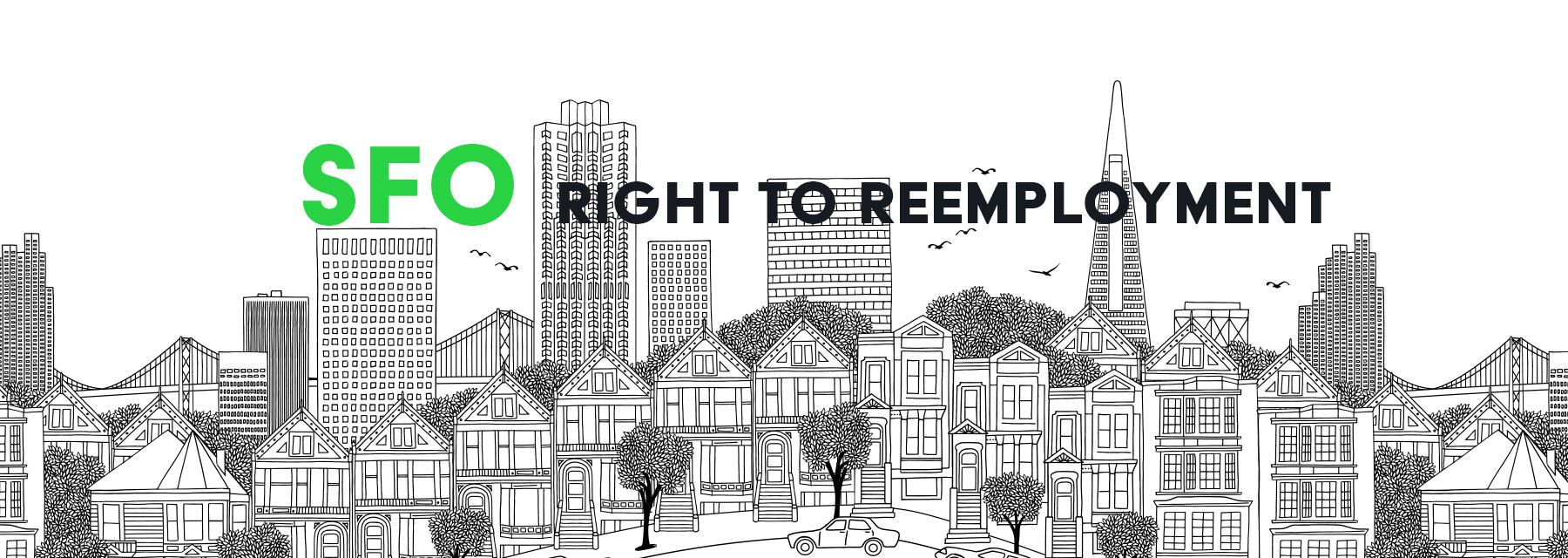UPDATED – *On September 11, 2020, the San Francisco mayor approved a temporary emergency ordinance, protecting employees, contractors, and job applicants from adverse employment action if they test positive for coronavirus, or choose to isolate, or quarantine, due to COVID-19 exposure or symptoms. The ordinance expires on November 10, 2020 unless it is reenacted by the San Francisco Board of Supervisors.
UPDATED August 11, 2020 – The San Francisco Office of Economic Workforce Development (OEWD) has released guidance, an FAQ and model written notices to the OEWD.
On June 23, 2020, the San Francisco Board of Supervisors passed the “Back to Work” emergency ordinance (the “Ordinance”) to address severe economic harm to individuals unable to work due to the public health emergency. The Ordinance temporarily creates a right to reemployment for employees laid off due to COVID-19 and creates notice and reporting obligations on employers who have recently laid off, or plan to lay off, employees due to COVID-19.
What is the Effective Date of the Ordinance?
The Ordinance became effective July 3, 2020 and will stay in effect for 60 days (through September 1, 2020), unless it is extended further by the Board of Supervisors.
Which Employers does the Ordinance apply to?
The Ordinance applies to employers operating in San Francisco that employ (or have employed) 100 or more employees on or after February 25, 2020. The definition of “employer” under the Ordinance expressly excludes certain healthcare service providers and suppliers. For a list of exclusions, see Section 4, Definitions.
Which Employees does the Ordinance apply to?
The Emergency Ordinance defines “eligible worker” as a person:
- Employed for at least 90 days of the calendar year preceding the date on which their employer provided or provides written notice to the employee of a layoff; and
- Who was or is separated from employment due to a layoff as defined by the Ordinance.
What is Considered a “Layoff” under the Ordinance?
The Ordinance defines layoff as:
- A separation of employment of 10 or more employees,
- During any 30-day period, commencing on or after February 25, 2020,
- Caused by the employer’s lack of funds or lack of work for its employees, as a result of the public health emergency and any San Francisco Shelter-in-Place (SIP) orders.
The Ordinance includes any layoff conducted in conjunction with the closure or cessation of an employer’s business operations in San Francisco in its definition. This means that there is no exception to the Ordinance if a business ceases operations and meets the above requirements.
What is the Layoff Notice Requirement?
Employers must provide written notice to the affected employee and must provide written notice to the San Francisco Office of Economic Workforce Development (OEWD).
Written Notice to Employee
The Ordinance requires that employers provide written notice of a covered layoff, in a language understood by the impacted employee, at or before the time the layoff becomes effective. The written notice must include:
- A notice of the covered layoff and the layoff’s effective date;
- A summary of the right to reemployment created by the Ordinance; and
- A telephone number for a hotline (confirmed in OEWD guidance as (415) 701-4817) , to be operated by the OEWD, which eligible workers may call to receive information regarding the right to reemployment created by the Ordinance, as well as navigation services and other resources related to unemployment.
If the layoff occurred before the effective date of the Ordinance, employers must provide notice to those former employees by August 2, 2020 (within 30 days of the effective date).
Written Notice to San Francisco Office of Economic Workforce Development
Employers are also required to provide written notice to the San Francisco’s OEWD within 30 days of the date of a covered layoff, or if unforeseeable, within seven days of the separation of the tenth employee in a 30-day period due to COVID-19 or any SIP order. The OEWD issued guidance clarifying that for covered layoffs occurring prior to August 7, 2020, employers must report the required layoff notice to the OEWD within 30 days of August 7, 2020. For all covered layoffs after August 7, 2020, the notice to the OEWD must be made within 30 days from the date of the layoff.
The written notice to OEWD must include the following with respect to affected employees:
- The total number of employees located in San Francisco affected by the layoff;
- The job classification at the time of separation;
- The original hire date; and
- The date of separation from employment.
The OEWD has made model notices available.
What is the Employer’s Obligation to Offer Reemployment?
An employer that conducts a layoff covered by the Ordinance on or after February 25, 2020, and then subsequently seeks to fill the same, or substantially similar, position previously held by a laid off worker must:
- Offer reemployment following layoff to the same position – If filling the eligible worker’s former position, the employer must first offer them an opportunity for reemployment before offering it to another person.
- Offer reemployment following layoff to a similar position – If the employer is filling any position substantially similar to the eligible worker’s former position that is also located in San Francisco, the employer must first offer them an opportunity for reemployment to this position before offering it to another person. A “substantially similar” position includes any of the following:
- A position with comparable job duties, pay, benefits, and working conditions to the eligible worker’s position at the time of layoff;
- Any position in which the eligible worker worked in the 12 months preceding the layoff; and
- Any position for which the eligible worker would be qualified, even if that position would require training, if the employer would otherwise make training available to a new employee upon hire.
- Offer reemployment in order of seniority – If an employer intends to offer an eligible worker reemployment and laid off more than one eligible worker from the same job classification, the employer must make offers of reemployment based on seniority of the earliest hire date.
What is an Offer of Reemployment?
An employer must engage in good faith efforts to notify and extend offers of reemployment to eligible workers by telephone and e-mail. If the employer is unable to make contact through those means, the employer must attempt to contact the eligible worker by certified mail or courier delivery. The Ordinance outlines specific requirements and timelines for delivery and acceptance of an offer under Section 7., Notice of Offer and Acceptance.
Are there Exceptions to the Offer of Reemployment?
Yes, employers may withhold an offer of reemployment under the following circumstances:
- After learning about employee misconduct – an employer may withhold an offer reemployment if an employer subsequently learns that the eligible worker engaged in any act of dishonesty, violation of law, violation of policy or rule of the employer, or other misconduct during their employment.
- Severance agreement – an employer may withhold an offer of reemployment if:
- The employee separated as part of a covered layoff between February 25, 2020 (the beginning of the public health emergency) and July 3, 2020 (effective date of the Emergency Ordinance); and
- The employer and eligible worker executed a severance agreement containing a general release of claims against the employer prior to July 3, 2020.
- Position was filled prior to the Ordinance – an employer may withhold an offer of reemployment if:
- The eligible worker separated as part of a covered layoff between February 25, 2020 and July 3, 2020; and
- The employer hired another person for the position, or a substantially similar position, prior to July 3, 2020.
What are an Employer’s Reporting Requirements for Offers of Reemployment?
Employers must notify the OEWD in writing of all offers of reemployment, along with any acceptances and rejections of such offers by eligible workers. The OEWD has made model notices available. The Ordinance does not suggest a deadline for which employers must notify the OEWD, however, further guidance is anticipated.
Does an Employer Have a Duty to Accommodate an Eligible Worker?
The employer must accommodate any eligible worker experiencing a family care hardship, as defined by the Ordinance, that impacts their ability to perform or satisfy a job requirement.
An eligible worker experiencing a family care hardship is one who is unable to work due to either:
- A need to care for their child whose school or place of care has been closed, or whose childcare provider is unavailable, as a result of the public health emergency, and no other suitable person is available to care for the child during the period of such leave;
- Or any reason under the San Francisco Paid Sick Leave Ordinance for which a person may use paid sick leave to provide care for someone other than themselves. (See Administrative Code 12W.4(a))
Examples of accommodations under the Ordinance include, but are not limited to, modifying work schedules, modifying the number of hours to be worked, or permitting telework. This duty to accommodate expires upon the expiration of the Ordinance.
Are there other Prohibitions?
The Ordinance prohibits employer from discriminating against laid-off workers with family hardships and allows them to request reasonable accommodation for those hardships.
What are the Recordkeeping Requirements?
If an employer is conducting a layoff covered under the Ordinance, they must retain the following records for at least two years for each eligible worker:
- Legal name;
- Job classification at the time of separation from employment;
- The date of hire;
- The last known address of residence;
- Last known email address;
- Last known telephone number; and
- A copy of the written notice regarding the covered layoff provided to the employee.
Employer Considerations
Given the Ordinance’s immediate effective date, and creation of several new obligations, employers who have recently conducted, or are considering, layoffs due to COVID-19, should consult with employment counsel to determine whether and how the Ordinance might apply in addition to obligations that might be triggered under the state and federal WARN Act(s).
Additional Resources
- Frequently Asked Questions
- Resources for Employers Impacted by COVID-19
- San Francisco Office of Labor Standards Enforcement
- San Francisco Office of Economic and Workforce Development
Disclaimer: This content is intended for informational purposes only and should not be construed as legal, medical or tax advice. It provides general information and is not intended to encompass all compliance and legal obligations that may be applicable. This information and any questions as to your specific circumstances should be reviewed with your respective legal counsel and/or tax advisor as we do not provide legal or tax advice. Please note that this information may be subject to change based on legislative changes. © 2020 Sequoia Benefits & Insurance Services, LLC. All Rights Reserved




